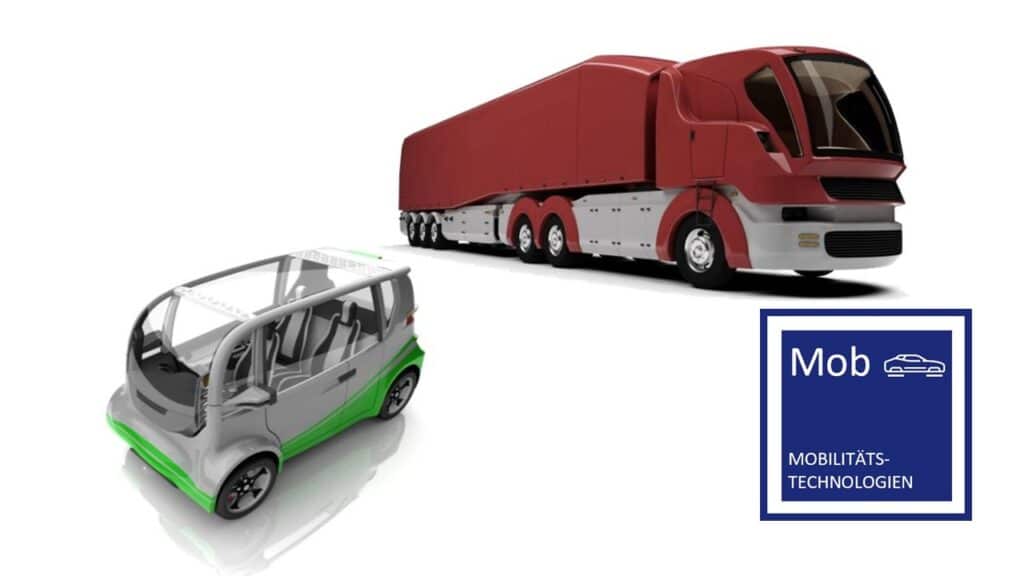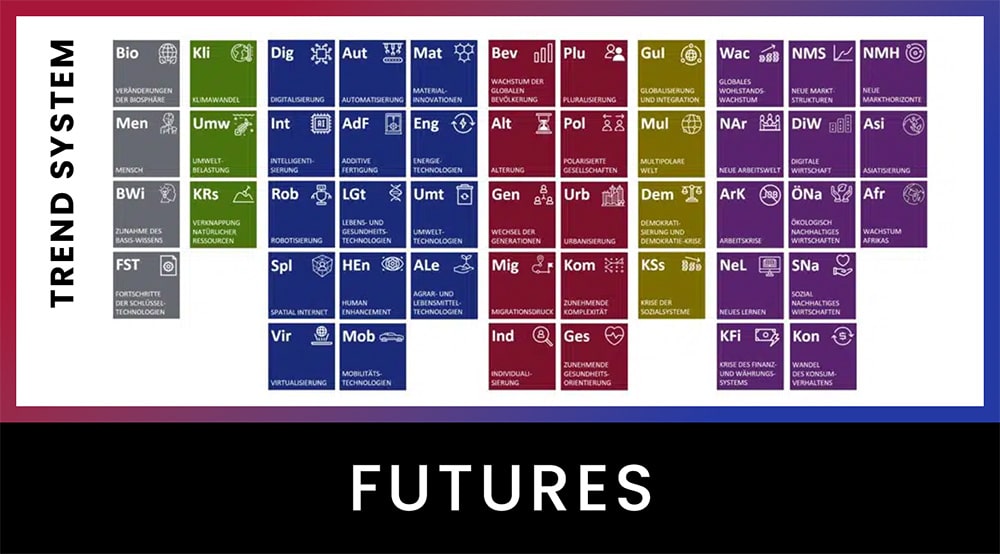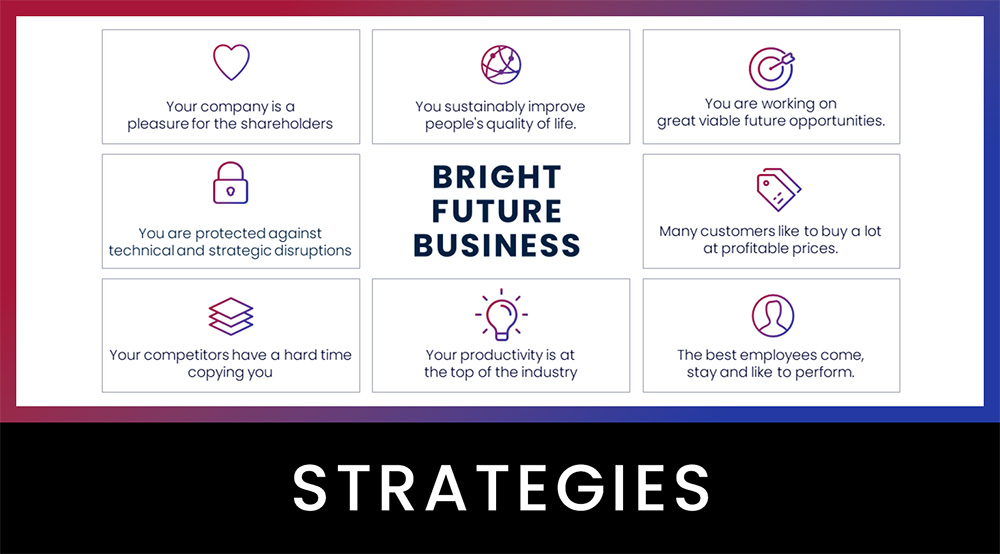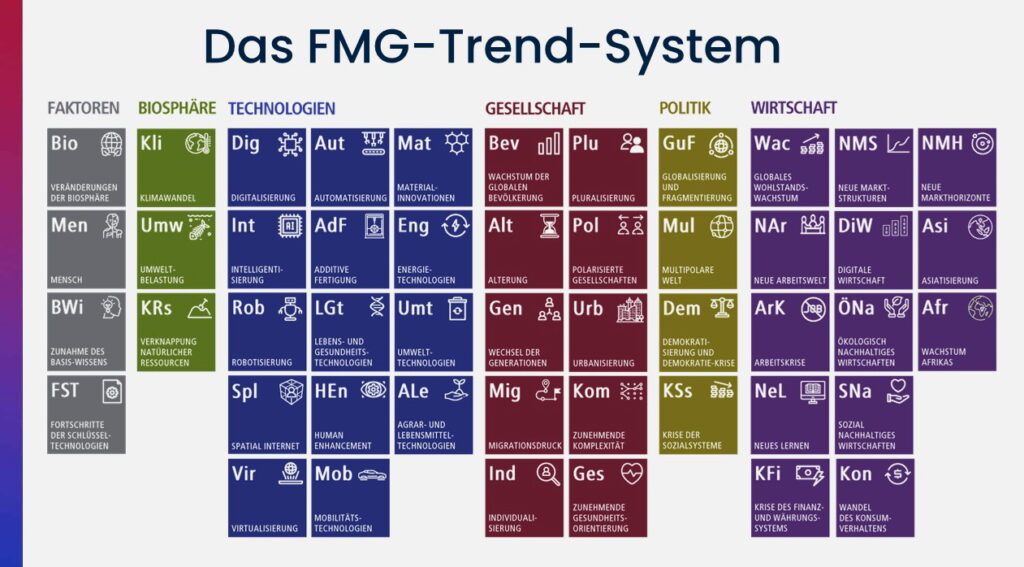Megatrend mobility technologies
From the FMG Trend System: For your future-proof company
Mobility of the future: connected, autonomous and emission-free
Mobility is a central element of modern societies – it ensures personal freedom, economic performance and social participation. However, the understanding of mobility is undergoing radical change. New technologies, the desire for sustainability and rapid progress in digitalization are driving this change.
Mobility technologies will ensure that people and goods can travel more flexibly, safely, efficiently and environmentally friendly in the future. They are not only changing road traffic, but are also having a profound impact on existing value chains and opening up new markets – from urban private transport to global logistics. To the overview of all megatrends

What do mobility technologies mean for companies?
The term mobility technologies encompasses all technical developments that contribute to making transportation smarter, more resource-efficient and more connected. The combination of vehicle technology, digital infrastructure and real-time data enables new forms of transportation – both in private transport and in logistics.
For a large number of companies – whether automotive manufacturers, suppliers, logistics service providers, mechanical engineers or IT providers – mobility technologies are not just a topic for the future, but a fundamental part of their current business model. Anyone who develops or sells vehicles, transportation technology, components or software solutions today is directly affected by technological change. Companies whose business model is based on efficient logistics and mobility are also dependent on efficient, reliable and scalable technologies.
At the same time, new business areas are opening up for many companies in mobility services, platform solutions, data infrastructures and sustainable vehicle concepts. New requirements for infrastructure, energy supply and regulatory frameworks are also emerging.
- Alongside human motives, mobility technologies and other technologies are the most transformative trends. We use our tools to shape the world, mostly to our advantage.
- The mobility technology megatrend is just one of many that could be relevant to the future of your business.
- In addition to megatrends from the biosphere, society, politics and the economy, FMG’s trend system also includes the drivers that trigger trends such as mobility technologies, the future factors. To the overview of all megatrends
Four key developments in mobility technologies
1. autonomous vehicles
Autonomous vehicles are taking on more and more driving tasks independently – from steering and braking to changing lanes or parking. Thanks to the combination of sensors, connectivity and artificial intelligence, they can analyze traffic situations in real time and make decisions without human intervention.
In addition to the increase in comfort for drivers, autonomous driving will lead to greater safety, higher traffic performance and new mobility services. The biggest challenges lie in legal issues, data protection and social acceptance.
The following technologies play a central role in autonomous vehicles:
Vehicle-to-vehicle communication describes the exchange of information between neighboring vehicles, for example about obstacles, weather or braking maneuvers.
Vehicle-to-road communication enables interaction with traffic lights, traffic signs or roadworks information via networked infrastructure systems.
Intelligent navigation systems recognize individual driving patterns and suggest optimized routes based on real-time data.
Predictive driving and drive control uses map and sensor data to improve fuel consumption, driving comfort and efficiency in real time.
Column driving on highways increases safety and efficiency through coordinated driving of several vehicles at close intervals.
2. electromobility
Electromobility is a key factor in the energy transition in transportation. Pure electric vehicles and plug-in hybrids as a transitional technology are increasingly replacing vehicles with combustion engines. They reduce noise and pollutant emissions and enable greater independence from fossil fuels.
Thanks to falling battery costs, longer ranges and the expansion of the charging infrastructure, electric mobility is becoming increasingly suitable for mass use – in cities, in rural areas and in logistics.
The following aspects are becoming increasingly important:
Plug-in hybrid vehicles combine the combustion engine with a powerful electric motor and enable shorter everyday journeys to be made purely electrically.
Interchangeable battery terminals allow the robot-assisted replacement of empty batteries with full ones within a few minutes – a potential game changer for commercial vehicles.
E-bikes and pedelecs open up new forms of urban mobility in which electric assistance meets individual movement.
Electric cars are a growing part of road traffic thanks to their efficiency, reduced emissions and quiet driving behavior.
- Intelligent charging infrastructure enables the integration of vehicles into electricity grids and contributes to grid stability – keyword: smart grid.
3. logistics innovations
In logistics, rising customer expectations meet growing volumes of goods. At the same time, climate protection and urbanization are leading to new demands for efficiency, flexibility and sustainability in the supply chain. Industry 4.0 technologies, data-driven processes and automation form the backbone of this transformation.
Logistics is becoming networked, forward-looking and increasingly low-emission. The relevant aspects include
Intralogistics innovations improve internal material and goods flows through automation and IoT.
Logistics solutions for the last mile combine drones, delivery robots, bicycle couriers or autonomous vehicles for more flexibility in delivery.
Synchromodal networks allow seamless switching between different modes of transportation based on real-time data.
Transparent supply chains enable goods to be tracked seamlessly using RFID, GPS and sensor technology.
Predictive logistics analyzes demand and inventory data with AI to get shipments to the customer before the order is placed.
Digital logistics platforms connect all players along the supply chain and increase the utilization of existing resources.
4. transportation innovations
New mobility concepts that link different modes of transport and use digital control are needed to counter the increasing volume of traffic. Transport innovations improve the efficiency of existing systems and create new ways of transporting people and goods.
The goal is sustainable, city-friendly and climate-friendly mobility – with alternative drive systems, new carriers and intelligent infrastructure. The following developments can be seen in the area of transportation innovations:
Alternative transportation systems on existing infrastructure enable new solutions such as self-driving convoys on highways or flexible minibuses.
Ground effect vehicles use the aerodynamic effect over water surfaces for efficient, fast transportation.
Maglev trains combine high speed with low friction and noise.
Tube-based transport systems – such as pneumatic systems – offer solutions for inner-city material transportation.
Multimodal transportation systems digitally link cars, trains, bicycles, planes and ships to create a seamless overall system.
Aviation technologies rely on improved engines, lighter materials and alternative fuels to reduce emissions.
Airships and cargo zeppelins could return as an environmentally friendly freight solution for regions that are difficult to access.
Individual air transport is rethinking mobility – for example through air cabs or personal micro-airplanes.
Shipbuilding innovations bring more efficient drives and automation to maritime logistics.
Satellite navigation optimizes route guidance, tracking and location services with centimetre-precise positioning.
Conclusion: using mobility technologies proactively as an opportunity
Mobility is already a key economic factor today – for manufacturers, suppliers, infrastructure operators, logistics companies and many more. However, technological and regulatory change is confronting the previously dominant “combustion engine economy” with profound upheavals.
The key task for companies is to actively exploit the emerging potential – from new mobility services and emission-free drives to data-based business models – and to further develop their mobility business in a future-proof manner.
Companies can open up new fields of value creation, further develop existing products or offer new mobility-related services.
At the same time, efficiency gains can be realized – for example through digital logistics solutions, automated transport processes or smarter traffic planning.
- With the Future Radar Program, you can identify how mobility technologies could change your company and how you can use them as a strategic opportunity.



































